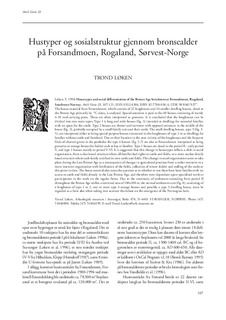| dc.contributor.author | Løken, Trond | |
| dc.date.accessioned | 2013-05-23T12:07:50Z | |
| dc.date.available | 2013-05-23T12:07:50Z | |
| dc.date.issued | 1998 | |
| dc.identifier.citation | Løken, T. (1998) Hustyper og sosialstruktur gjennom bronsealder på Forsandmoen, Rogaland, sørvest-Norge. I T. Løken (red.), Bronsealder i Norden - regioner og interaksjon : foredrag ved det 7. Nordiske bronsealdersymposium i Rogaland 31. august-3. september 1995 (s. 107-121). Stavanger : Arkeologisk Museum i Stavanger | no_NO |
| dc.identifier.uri | http://hdl.handle.net/11250/181494 | |
| dc.description.abstract | The house-material from Forsandmoen, which consists of 22 longhouses and 16 smaller dwelling houses, dated to
the Bronze Age primarily by 14C-dates, is analysed. Special attention is paid to the 69 houses consisting of merely
4-10 roof-carrying posts. These are often interpreted as granaries. It is concluded that the longhouses can be
divided into two main types: Type 1 is long and wide houses (fig. 1) intended as dwellings for extended families
with no space for the cattle. Type 2 houses are shorter and narrower with opposed entrances in the middle of the
house (fig. 2), probably occupied by a small family unit and their cattle. The small dwelling houses, type 3 (fig. 3-
5), are interpreted either as being special purpose houses connected to the longhouses of type 2 or as dwellings for
families without cattle and farmland. Due to their location in the near vicinity of the longhouses and the frequent
finds of charred grains in the postholes the type 4 houses (fig. 5-7) are also at Forsandmoen interpreted as being
granaries or storage houses for fodder such as hay or heather. Type 1 houses are dated to the period II - early period
V, and type 2 houses mainly to period V-VI. It is suggested that this change in housetypes reflects a shift in social
organization, from a clan-based structure where all families had rights to cattle and fields, to a more nuclear family
based structure where each family unit had its own cattle and fields. This change in social organization seem to take
place during the Late Bronze Age as a consequence of changes in agricultural practises from a rather extensive to a
more intensive organization with fertilisation of the fields, collection of winter fodder and stalling of the cattle at
this point in time. The house material also raises the question as to whether or not there have been families with no
access to cattle and fields already in the Late Bronze Age, and therefore were dependant upon specialized work or
participation in the work on the regular farms. Due to the continuity of settlement extending from period II
throughout the Bronze Age within a restricted area of 100x100 m, the normal settlement unit (fig. 8), consisting of
a longhouse of type 1 or 2, one or more type 4 storage houses and possibly a type 3 dwelling house, must be
regarded as a farm also when taking into account the debate on the emergence of the Norwegian farm. | no_NO |
| dc.language.iso | nob | no_NO |
| dc.publisher | Arkeologisk museum i Stavanger | no_NO |
| dc.relation.ispartofseries | AmS-Varia;33 | |
| dc.subject | arkeologi | no_NO |
| dc.subject | Forsandmoen | no_NO |
| dc.subject | Norge | no_NO |
| dc.subject | Rogaland | no_NO |
| dc.subject | bronsealder | no_NO |
| dc.title | Hustyper og sosialstruktur gjennom bronsealder på Forsandmoen, Rogaland, sørvest-Norge | no_NO |
| dc.type | Chapter | no_NO |
| dc.type | Peer reviewed | no_NO |
| dc.subject.nsi | VDP::Humanities: 000::Archeology: 090::Nordic archeology: 091 | no_NO |
